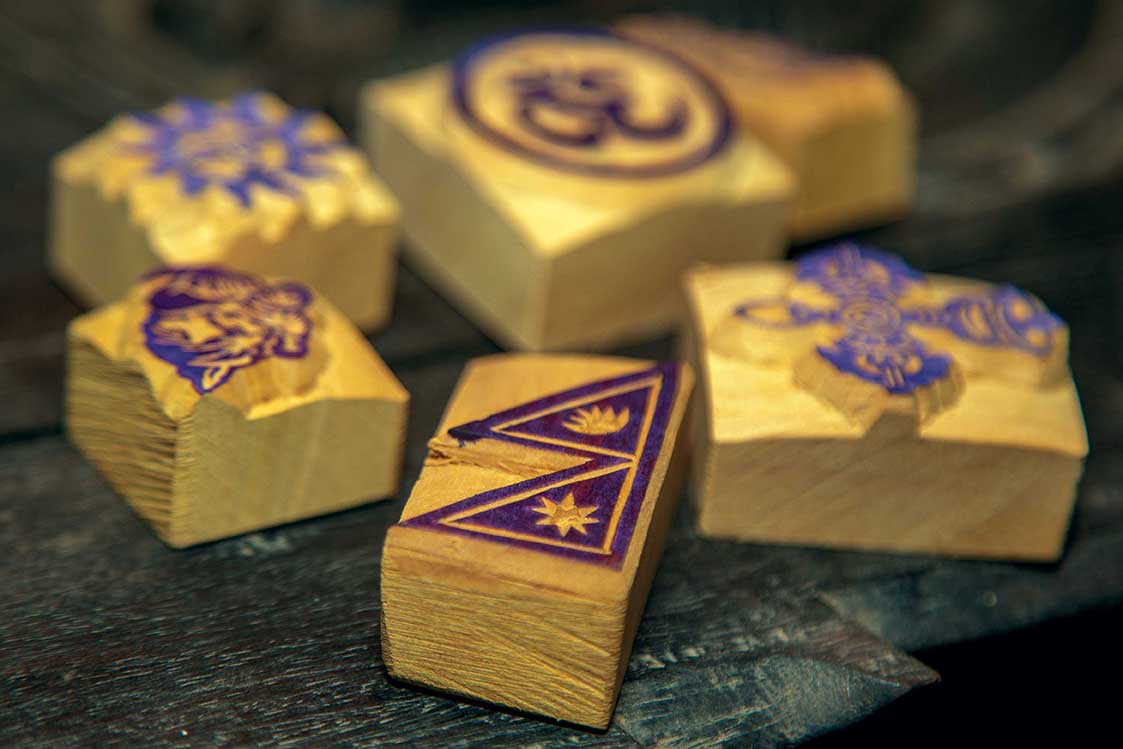Prem Shrestha is a devout man.Every day before he opens up for business, he buys a peda (local sweet) from a mithai pasal (sweet shop). As he opens his shop where he sells and repairs household electronic items, he mumbles a prayer, lights an incense, fanning the perfume to the all corners and offers the sweet to the picture of a deity in one corner of his shop. The deity, apparently angered by ferocious looking beasts is giving them the thrashing of their lives. He has one beast choke hold, with a free hand he is swinging the other one about, ready to chuck it in a painful trajectory. And, if redness of his face does not betray his anger, then he must be too huffed and puffed from all that thrashing.
 Bhimsen the protector
Bhimsen the protector
Shrestha is a Newar businessman. Like any other businessman opening up for the day, he starts his day with a prayer. But you would be surprised to whom. While across town in Kathmandu, where his counterpart Marwari businessmen offer their homage to Laxmi, the goddess of wealth, Shrestha offers his homage to the fearsome Bhimsen, the
protector. If Laxmi is considered goddess of wealth, then Bhimsen is regarded as its protector. But, pray tell us why? ‘Well, it’s good to be wealthy. But that amounts to nothing if you cannot protect it’. One hears this type of logic when you ask the inevitable question, such as why.
No one knows for sure when or why Bhimsen’s ferocious image was married to Laxmi, assigning him as her protector. But, if you happen to chat with an old-timer, s/he would surely tell you that it was so since ‘time immemorial’. Whatever be the reason, one has to appreciate the audacity with which the legends and the lore of the past have been kept alive by the younger generation.
A jatra fit for a deity
Much to the joy of revelers’ and devotees alike, the jatra starts as the last of the sun’s rays retire for the night. The starting place is from his humble abode in the Darbar Square, where scores of people have gathered to participate in the festival with wholehearted enthusiasm. It finally begins when, amid the huge cheers from the onlookers, the idol of the deity is placed in the palanquin especially built to lug Bhimsen about town.
The procession is taken through the narrowly ancient streets of Patan, in route that roughly encircles the temple. Throughout the route, people have spilled across the streets where there is much merry-making, which is evident by the gales of laughter mixing with the noise blaring from all direction. The atmosphere is enlivened by the strong aroma of home-made incense. Most of the devotees are burning incense right and left and the aroma hunts the streets numbing every sense, demanding torrents of tear as sacrifice. There is ancient magic afloat in the air, the kind that makes people wish that the merry making time would last forever. All eyes are scanning the horizon, or at least the last galli or the chowk visible, before the buildings closed in on the either side.
The distant music and the cheering is getting louder and some of the people sitting on the sidewalks have started to run their hands around their person, in desperate attempts to find the match to light the incense. For the luckless, there are always the street vendors who have set up their pasals in convenient places. They are selling the ‘best’ and the most aromatic ‘praying aid’ the incense industry has to offer, and at Rs 10 per pack, it’s a bargain. The distant hazel of smoke is getting closer and so is the cheering, you can almost make our part of the incessant cheers. If you listen closely you can almost make out these words: ‘Hail, Lord Bhimsen!’
The sight of the Bhimsen’s palanquin drawn through the streets invokes awe-inspiring
reaction. If you could put an image into poetry, that would be it. The palanquin is strewn in the mesh of bamboo sticks, manned by able bodied men who are sweating like anything. In the chariot, the deity is ‘sitting’ in full royal grace, dressed in his Sunday best (if you have to define the dress, nothing gives a clear picture than being dressed in their Sunday best however ironic it may seem, such as in this case).
On both sides of the street, people are craning their head for a better view. Some of them are praying hard. Closing their eyes and concentrating till their eye brows bridged their gap, they are busy reciting prayers, wishes and songs of gratitude in an incoherent mumble. Even though praying is one of those businesses that you would like to conduct in solitude, no one is looking any embarrassed than the other guy. They are all here to prostate before their protector.
Most of the crowd comprise of businessmen, calling out to Bhimsen till their throats are soar, burning incense until their eyes have become tomato red. But, do take a glance, notice the unique concoction of people that have poured out in the streets. Not all of them are businessman, in the total sense of the word. And, surely, not all of them are religious for that matter. So, why they are here? Well, like the gods before them, they all love a good show and can tell when one is about to begin.
Jatras are, if you dissect the word, after all a form of street theater. There are various rasa floating about, the religious ranga (color) being the most prominent here. Even Shakespeare puts it that the world is a stage and so on and so forth. After all, aren’t we all conducting our life as if it is our primary business? And, a business does require a protector, does it not?










